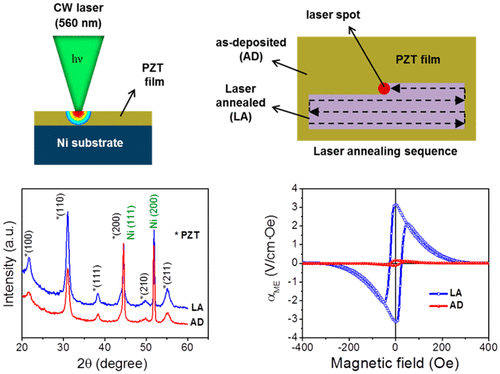当前位置:
X-MOL 学术
›
ACS Appl. Mater. Interfaces
›
论文详情
Our official English website, www.x-mol.net, welcomes your
feedback! (Note: you will need to create a separate account there.)
Enhanced Self-Biased Magnetoelectric Coupling in Laser-Annealed Pb(Zr,Ti)O3 Thick Film Deposited on Ni Foil
ACS Applied Materials & Interfaces ( IF 8.3 ) Pub Date : 2018-01-08 00:00:00 , DOI: 10.1021/acsami.7b16706 Haribabu Palneedi 1 , Deepam Maurya 2 , Liwei D. Geng 3 , Hyun-Cheol Song 2, 4 , Geon-Tae Hwang 1 , Mahesh Peddigari 1 , Venkateswarlu Annapureddy 5 , Kyung Song 6 , Yoon Seok Oh 7 , Su-Chul Yang 8 , Yu U. Wang 3 , Shashank Priya 2 , Jungho Ryu 1, 9
ACS Applied Materials & Interfaces ( IF 8.3 ) Pub Date : 2018-01-08 00:00:00 , DOI: 10.1021/acsami.7b16706 Haribabu Palneedi 1 , Deepam Maurya 2 , Liwei D. Geng 3 , Hyun-Cheol Song 2, 4 , Geon-Tae Hwang 1 , Mahesh Peddigari 1 , Venkateswarlu Annapureddy 5 , Kyung Song 6 , Yoon Seok Oh 7 , Su-Chul Yang 8 , Yu U. Wang 3 , Shashank Priya 2 , Jungho Ryu 1, 9
Affiliation

|
Enhanced and self-biased magnetoelectric (ME) coupling is demonstrated in a laminate heterostructure comprising 4 μm-thick Pb(Zr,Ti)O3 (PZT) film deposited on 50 μm-thick flexible nickel (Ni) foil. A unique fabrication approach, combining room temperature deposition of PZT film by granule spray in vacuum (GSV) process and localized thermal treatment of the film by laser radiation, is utilized. This approach addresses the challenges in integrating ceramic films on metal substrates, which is often limited by the interfacial chemical reactions occurring at high processing temperatures. Laser-induced crystallinity improvement in the PZT thick film led to enhanced dielectric, ferroelectric, and magnetoelectric properties of the PZT/Ni composite. A high self-biased ME response on the order of 3.15 V/cm·Oe was obtained from the laser-annealed PZT/Ni film heterostructure. This value corresponds to a ∼2000% increment from the ME response (0.16 V/cm·Oe) measured from the as-deposited PZT/Ni sample. This result is also one of the highest reported values among similar ME composite systems. The tunability of self-biased ME coupling in PZT/Ni composite has been found to be related to the demagnetization field in Ni, strain mismatch between PZT and Ni, and flexural moment of the laminate structure. The phase-field model provides quantitative insight into these factors and illustrates their contributions toward the observed self-biased ME response. The results present a viable pathway toward designing and integrating ME components for a new generation of miniaturized tunable electronic devices.
中文翻译:

镍箔上沉积的激光退火Pb(Zr,Ti)O 3厚膜中的增强自偏置磁电耦合
在包含4μm厚的Pb(Zr,Ti)O 3的叠层异质结构中证明了增强的自偏置磁电(ME)耦合(PZT)膜沉积在厚度为50μm的柔性镍(Ni)箔上。利用一种独特的制造方法,该方法结合了通过真空(GSV)颗粒喷涂在室温下沉积PZT膜和通过激光辐射对膜进行局部热处理的方法。这种方法解决了在金属基板上集成陶瓷膜的挑战,这通常受到在高处理温度下发生的界面化学反应的限制。激光诱导的PZT厚膜结晶度的改善导致PZT / Ni复合材料的介电,铁电和磁电性能增强。从激光退火的PZT / Ni薄膜异质结构中获得了3.15 V / cm·Oe量级的高自偏置ME响应。该值对应于ME响应增加了约2000%(0。从沉积的PZT / Ni样品中测得16 V / cm·Oe)。该结果也是同类ME复合系统中报告的最高值之一。已经发现,PZT / Ni复合材料中自偏置ME耦合的可调性与Ni中的退磁场,PZT和Ni之间的应变不匹配以及层合结构的挠曲力矩有关。相场模型提供了对这些因素的定量洞察力,并说明了它们对观察到的自偏ME响应的贡献。结果为设计和集成用于新一代小型可调谐电子设备的ME组件提供了一条可行的途径。已经发现,PZT / Ni复合材料中自偏置ME耦合的可调性与Ni中的退磁场,PZT和Ni之间的应变不匹配以及层合结构的挠曲力矩有关。相场模型提供了对这些因素的定量洞察力,并说明了它们对观察到的自偏ME响应的贡献。结果为设计和集成用于新一代小型可调谐电子设备的ME组件提供了一条可行的途径。已经发现,PZT / Ni复合材料中自偏置ME耦合的可调性与Ni中的退磁场,PZT和Ni之间的应变失配以及层压结构的挠曲力矩有关。相场模型提供了对这些因素的定量洞察力,并说明了它们对观察到的自偏ME响应的贡献。结果为设计和集成用于新一代小型可调谐电子设备的ME组件提供了一条可行的途径。
更新日期:2018-01-08
中文翻译:

镍箔上沉积的激光退火Pb(Zr,Ti)O 3厚膜中的增强自偏置磁电耦合
在包含4μm厚的Pb(Zr,Ti)O 3的叠层异质结构中证明了增强的自偏置磁电(ME)耦合(PZT)膜沉积在厚度为50μm的柔性镍(Ni)箔上。利用一种独特的制造方法,该方法结合了通过真空(GSV)颗粒喷涂在室温下沉积PZT膜和通过激光辐射对膜进行局部热处理的方法。这种方法解决了在金属基板上集成陶瓷膜的挑战,这通常受到在高处理温度下发生的界面化学反应的限制。激光诱导的PZT厚膜结晶度的改善导致PZT / Ni复合材料的介电,铁电和磁电性能增强。从激光退火的PZT / Ni薄膜异质结构中获得了3.15 V / cm·Oe量级的高自偏置ME响应。该值对应于ME响应增加了约2000%(0。从沉积的PZT / Ni样品中测得16 V / cm·Oe)。该结果也是同类ME复合系统中报告的最高值之一。已经发现,PZT / Ni复合材料中自偏置ME耦合的可调性与Ni中的退磁场,PZT和Ni之间的应变不匹配以及层合结构的挠曲力矩有关。相场模型提供了对这些因素的定量洞察力,并说明了它们对观察到的自偏ME响应的贡献。结果为设计和集成用于新一代小型可调谐电子设备的ME组件提供了一条可行的途径。已经发现,PZT / Ni复合材料中自偏置ME耦合的可调性与Ni中的退磁场,PZT和Ni之间的应变不匹配以及层合结构的挠曲力矩有关。相场模型提供了对这些因素的定量洞察力,并说明了它们对观察到的自偏ME响应的贡献。结果为设计和集成用于新一代小型可调谐电子设备的ME组件提供了一条可行的途径。已经发现,PZT / Ni复合材料中自偏置ME耦合的可调性与Ni中的退磁场,PZT和Ni之间的应变失配以及层压结构的挠曲力矩有关。相场模型提供了对这些因素的定量洞察力,并说明了它们对观察到的自偏ME响应的贡献。结果为设计和集成用于新一代小型可调谐电子设备的ME组件提供了一条可行的途径。











































 京公网安备 11010802027423号
京公网安备 11010802027423号